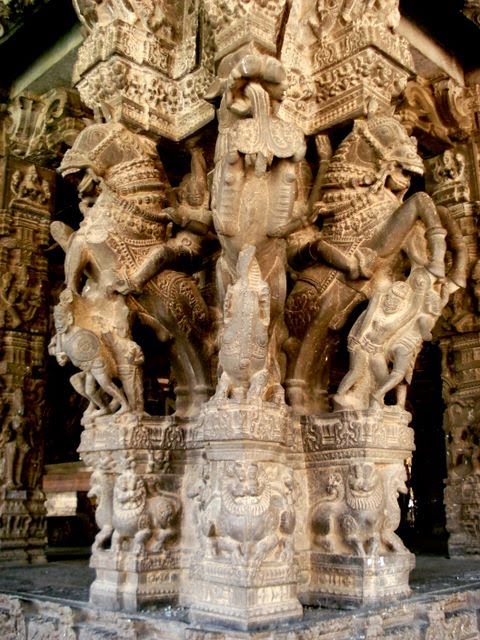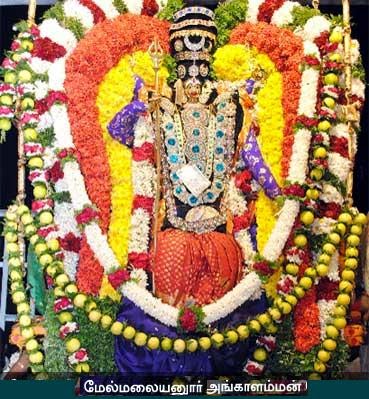Swamimalai Sri.Swaminatha Swami Temple
Swamimalai is hailed as one of the 6 padai veedu shrines of Skanda where he sojourned during his battle against the demon Soorapadman. It has been praised in Tirumurugaatruppadai of the tamil sangam period and by the Tiruppugazh hymns of Arunagirinathar.
Swamimalai is located in the vicinity of the temple town of Kumbhakonam. Very closeby is the grand temple of Tiruvalanchuzhi now in a state of neglect.
This temple is associated with the legend of Skanda having re-initiated his father Shiva, with the concept of the oneness of creation of Omkaram.
This temple is built at an elevation, on an artificially constructed mound, reached through a flight of steps. Although the shrine is of ancient origin, much of the structure seen now is of the 20th century.
The outermost prakaram of this temple is at the ground level. The second one is half way up the stairs, and the innermost prakaram is around the Swaminathan shrine.
At the lower level are shrines to Meenakshi and Sundareswarar (said to have been built by the Pandya ruler Varaguna Pandyan of Madurai who is also associated with the Mahalingaswamy temple at Tiruvidaimarudur) and the prakaram where the golden chariot is taken in procession on special occasions.
The Netra Vinayakar shrine is located adjacent to the flagstaff. The southern entrance of the temple has a 5 tiered rajagopuram. A flight of 60 steps representing the cycle of 60 years in the tamil (indian) system of beliefs leads to the Swaminathan shrine in the upper level. Facing the sanctum is an elephant and not a peacock. (See Kumarakottam at Chromepet near Chennai enshrining Swaminathan).
Subramaniar is enshrined with Valli alone in the shrine in the inner prakaram and he is known as Senapati. Also in the southern precincts of the inner prakaram is Subramanyar enshrined as Sabapathi again with Devasena, with his arms stretched as iseen in Natarajar images. Also enshrined is Shammukhar with his consorts Valli and Devasena.
There are also shrines to Mahalakshmi, Saraswathi, Veerabaagu, Arunagirinathar, Surya, Chandra, Idumban, and Dhandayutapani here.
The stala vriksham is the Nellimaram and this tree is said to be a manifestation of Bhudevi. The theerthams here are Vajra theertham, Saravana Theerhtam, Netra Pushkarini and Kumaratturai (Kaveri). Legend has it that a blind devotee was blessed with eyesight after a dip in the Netra Theertham as he arrived at the Netra Vinayakar shrine.
Festivals: Six worship services are carried out each day. The Kartikai asterism each month attracts large crowds. Skanda Sashti lasting for 6 days is one of the most important festivals celebrated here.
To perform pooja in swamymalai temple contact us in doshanivarthi@gmail.com
Swamimalai is hailed as one of the 6 padai veedu shrines of Skanda where he sojourned during his battle against the demon Soorapadman. It has been praised in Tirumurugaatruppadai of the tamil sangam period and by the Tiruppugazh hymns of Arunagirinathar.
Swamimalai is located in the vicinity of the temple town of Kumbhakonam. Very closeby is the grand temple of Tiruvalanchuzhi now in a state of neglect.
This temple is associated with the legend of Skanda having re-initiated his father Shiva, with the concept of the oneness of creation of Omkaram.
This temple is built at an elevation, on an artificially constructed mound, reached through a flight of steps. Although the shrine is of ancient origin, much of the structure seen now is of the 20th century.
The outermost prakaram of this temple is at the ground level. The second one is half way up the stairs, and the innermost prakaram is around the Swaminathan shrine.
At the lower level are shrines to Meenakshi and Sundareswarar (said to have been built by the Pandya ruler Varaguna Pandyan of Madurai who is also associated with the Mahalingaswamy temple at Tiruvidaimarudur) and the prakaram where the golden chariot is taken in procession on special occasions.
The Netra Vinayakar shrine is located adjacent to the flagstaff. The southern entrance of the temple has a 5 tiered rajagopuram. A flight of 60 steps representing the cycle of 60 years in the tamil (indian) system of beliefs leads to the Swaminathan shrine in the upper level. Facing the sanctum is an elephant and not a peacock. (See Kumarakottam at Chromepet near Chennai enshrining Swaminathan).
Subramaniar is enshrined with Valli alone in the shrine in the inner prakaram and he is known as Senapati. Also in the southern precincts of the inner prakaram is Subramanyar enshrined as Sabapathi again with Devasena, with his arms stretched as iseen in Natarajar images. Also enshrined is Shammukhar with his consorts Valli and Devasena.
There are also shrines to Mahalakshmi, Saraswathi, Veerabaagu, Arunagirinathar, Surya, Chandra, Idumban, and Dhandayutapani here.
The stala vriksham is the Nellimaram and this tree is said to be a manifestation of Bhudevi. The theerthams here are Vajra theertham, Saravana Theerhtam, Netra Pushkarini and Kumaratturai (Kaveri). Legend has it that a blind devotee was blessed with eyesight after a dip in the Netra Theertham as he arrived at the Netra Vinayakar shrine.
Festivals: Six worship services are carried out each day. The Kartikai asterism each month attracts large crowds. Skanda Sashti lasting for 6 days is one of the most important festivals celebrated here.
The history of the temple known as "Sthala Puranam" is as follows: Once, Lord Brahma, the creator of living beings, had disrespected Lord Muruga (the son of Lord Shiva) at the time of visiting Mount Kailash where Lord Shiva resides. Hence Lord Muruga got angry with Lord Brahma and asked him how he was creating living beings such as people, animals etc. Lord Brahma said that he was creating living beings with the help of the Vedas. On hearing the reply, Lord Muruga asked Lord Brahma to recite the slogans from such Vedas. Brahma started to recite the slogans with the Holy word called Pranav Mantra "Om".
At that time Lord Muruga stopped Lord Brahma and asked him to tell the meaning of the Pranava Mantra. Lord Brahma couldn't tell the meaning and hence Lord Muruga knocked Lord Bramha on his forehead with His clenched fists and punished him with imprisonment. With Brahma imprisoned, Lord Muruga took up the role of the Creator. Creation went better than usual, with Lord Muruga presiding over Satya-loka and Lord Brahma’s absence was unnoticed. Until one incident which brought the Devas to Satya-loka seeking Lord Brahma caused great surprise to them that Lord Bramha was imprisoned and Lord Muruga wearing the garb of the Creator. They requested Lord Vishnu to negotiate with Lord Muruga in order to release Lord Brahma. Unfortunately, this attempt was not successful. As a final resort, Lord Shiva then went to the rescue of Lord Brahma.
Lord Shiva came to Lord Muruga and asked him to release Lord Brahma from imprisonment. Lord Muruga refused to release him on the grounds, that Lord Brahma was not suitable to do the work, as he did not known the meaning of the Pranav Mantra(Hindi: ॐ AUM).So Lord Shiva asked Lord Muruga whether He knew the meaning Himself and to tell the meaning to him, for he too wished to know It's meaning. To this, Lord Muruga declared that this was the reason why Lord Shiva is the greatest of the Trinity, as he has no ego and willingly gave full respect to him becoming a disciple to Lord Muruga,his preceptor.
Lord Muruga extolled to Lord Shiva the meaning of the Pranava Mantra (Hindi: ॐ) who like a student listened with rapt attention from his beloved Son.
This important and interesting incident happened in Swamimalai and hence Lord Muruga is known as "Swaminatha Swami". The meaning of this name is "The Teacher of Lord Shiva".
To perform pooja in swamymalai temple contact us in doshanivarthi@gmail.com



















